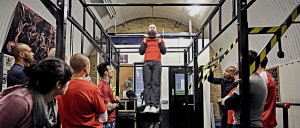
Anyone who’s worked out consistently for long enough has no doubt had to deal with an injury at some point. Setbacks can be frustrating, but if you train hard, eventually some type of injury may be inevitable.
In spite of over two decades of strength training, however, I’ve been fortunate enough to avoid anything serious. The worst I’ve had to deal with was a strained rotator cuff, some mild tendinitis and a few cuts, scrapes and bruises (mostly from freerunning and parkour). If you train smart, you should be able to avoid any serious injuries as well.
Listen to Your Body
One of the most common questions I get asked is, “Is it okay to work out every day?” There is no universal answer that applies to everyone, as individual conditioning varies greatly from person to person. As a general rule, however, let your body rest if you feel sore, achy or tired. If you want to work out and you’re still sore from a previous session, you might take a day to focus on flexibility or work around your sore muscles using a split routine. Another option is to simply do a low-intensity active recovery workout.
You might not always like what it has to say, but listening to your body is the best way to avoid injury. When you have aches and pains, you need to back off. Pay attention to how your body responds to different training programs and act accordingly.
Balancing Act
It is important to make sure that your strength training routine doesn’t favor any one movement pattern too heavily. The phrase antagonistic balance refers to maintaining a healthy symmetry between opposing muscle groups. If your routine is all push-ups and no pull-ups, you’ll likely wind up with shoulder problems and poor posture. Likewise, neglecting your glutes, hamstrings and lower back can also lead to joint pain and postural issues. This is why deadlifts and/or back bridges should be a mainstay of any fitness regimen.
Gradual Progress
People who get injured in training usually do so because they attempted something far outside of their capabilities. While ambition is a great asset, you’ve got to be objective about what your body is realistically capable of handling. I’m all for pushing the boundaries of human performance, but you have to do so gradually!
Check out my master list of exercises to get an idea of how to progress intelligently in the world of bodyweight strength training. You’ll typically want to get to about 10 reps of a given exercise before moving on to harder progressions. For static holds (like planks and L-sits), aim for a 30 second hold or longer.
Live and Learn
Injuries may sometimes be unavoidable, but I believe we are all ultimately responsible for our own fate. Be smart, stay humble and pick yourself up when you fall. If you do get injured, perhaps you can learn from the experience and avoid repeating your mistakes. Remember, an expert is just a beginner who didn’t quit.